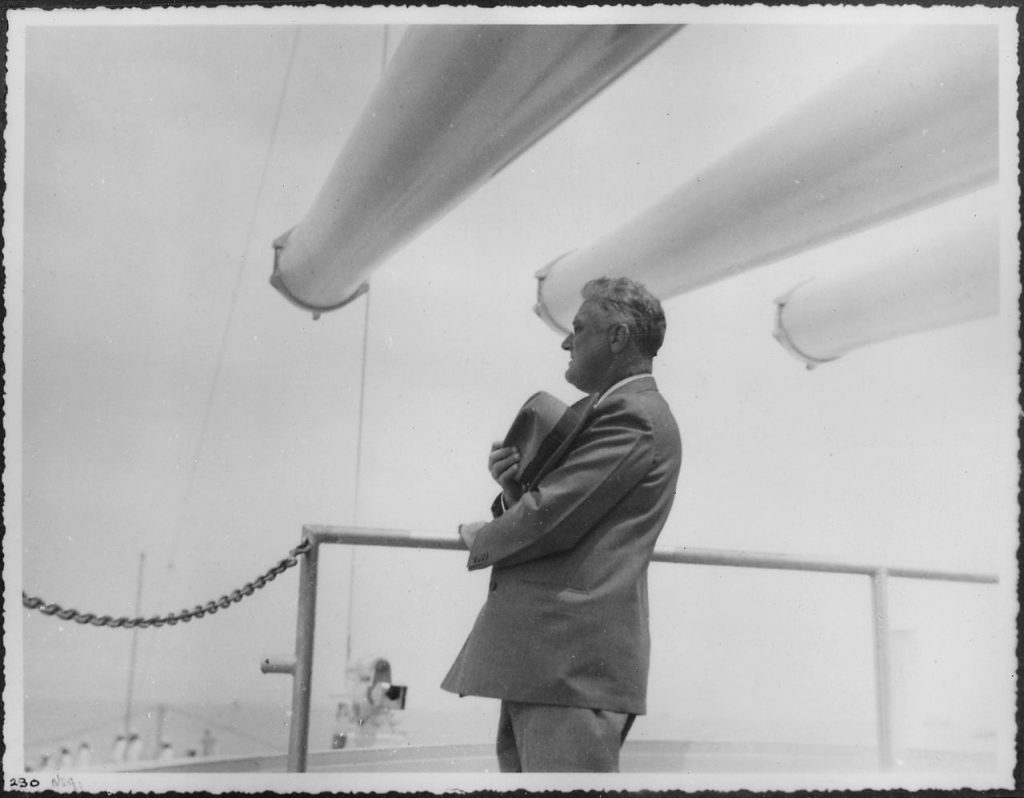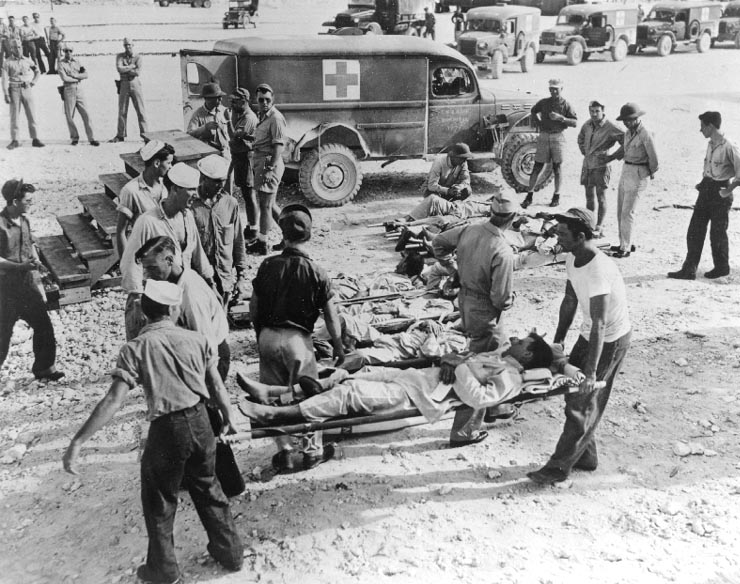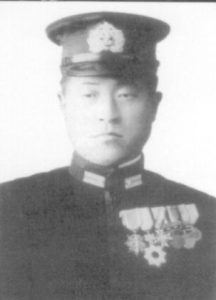The USS Indianapolis (hull classification symbol CA-35) was a US Navy cruiser that delivered the components of the Little Boy atomic bomb to Tinian Island. It was later sunk by a Japanese submarine in what became the worst naval disaster in US history. The ship’s secret mission, the questions surrounding its sinking, and the brutal trials endured by survivors have fascinated the public for decades.
Background and Tinian Mission
The Indianapolis was one of two Portland-class cruisers built during the early 1930s. It was formally commissioned in 1932. Before the war, it transported President Roosevelt on various occasions, including on a tour of South America. It was stationed with the Pacific Fleet in Pearl Harbor in the lead-up to the war. During the attack on December 7, 1941, the Indianapolis avoided damage because it was out on a training mission. The ship saw action in New Guinea, the Aleutian Islands, and the Battle of the Philippine Sea. It served along the way as the flagship for Admiral Raymond Spruance, Commander of the Fifth Fleet.
The Indianapolis was struck by a kamikaze attack during the battle of Okinawa. The impact of the plane itself did little damage, but the pilot managed to drop a bomb that punched a hole in the ship and led to several casualties. After emergency repairs, the ship went back to California for a full overhaul. While there, the Indianapolis was chosen for a secret mission: to transport components of the Little Boy uranium bomb to Tinian. The B-29 Enola Gay would eventually take off from the island for its fateful mission to Hiroshima.
 It set off for Tinian on July 16, 1945. Only a few days before, Captain Charles McVay III had received his orders from Rear Admiral William Purnell and Captain William Parsons. The ship took on many crew members in California. Enlisted men ending their tours of duty rotated out and were replaced by new enlistees. Despite the new crew’s inexperience, they were given little time to prepare for departure.
It set off for Tinian on July 16, 1945. Only a few days before, Captain Charles McVay III had received his orders from Rear Admiral William Purnell and Captain William Parsons. The ship took on many crew members in California. Enlisted men ending their tours of duty rotated out and were replaced by new enlistees. Despite the new crew’s inexperience, they were given little time to prepare for departure.
None of the crew knew what was contained in the crate and canister that were brought on board. The crate contained the “gun-type” mechanism for Little Boy. The uranium contained in the canisters was about half the US supply (the other half was flown to Tinian). It is unclear if McVay even knew what the contents were, though he claimed after the war that he did. He was, at least, aware of the secrecy and importance of his mission.
The two men who definitely did know were James Nolan and Robert Furman, two men from the Manhattan Project who accompanied the components to Tinian. The men were disguised as artillery officers, though it was not a very convincing cover. Furman, as an Army engineer, had some experience with artillery. But Nolan, a radiologist, raised some suspicion. He constantly had to return belowdecks to check the radiation from the canister, and was unable to answer basic questions about his supposed artillery experience.
Furman and Nolan were also probably the only ones who knew what caused the delay in launching the ship on the morning of July 16. In fact, they were waiting for a message about the result of the Trinity Test. With confirmation of that success, the Indianapolis left port. The ship stopped at Pearl Harbor briefly to refuel, before continuing on to Tinian. McVay made sure that the Indianapolis traveled quickly; it made the trip in record time. It arrived on July 26, and the bomb parts and their handlers disembarked. The cruiser’s crew were surprised by the number of high-ranking officers who supervised the mysterious cargo. Many of them would never find out what they had been transporting.
The Sinking
_underway_in_1944_(port)-1024x768.jpg) After leaving Tinian without the crew setting foot on the island, the Indianapolis carried on to Guam. It was then ordered to rendezvous with other ships at Leyte Gulf in the Philippines. Two controversial procedural flaws on Guam would eventually contribute to the cruiser’s disastrous fate.
After leaving Tinian without the crew setting foot on the island, the Indianapolis carried on to Guam. It was then ordered to rendezvous with other ships at Leyte Gulf in the Philippines. Two controversial procedural flaws on Guam would eventually contribute to the cruiser’s disastrous fate.
First, Navy higher-ups had two indications of submarine activity along the route to Leyte Gulf: intercepts from the codebreaking operation ULTRA, and the sinking of the destroyer Underhill. McVay was not made aware of these indications, and precautions were not taken. Apparently the US did not want Japan knowing that their codes had been broken. Second, McVay requested an escort, but his request was not granted. It is unclear why the request was denied, as a ship like the Indianapolis (which did not have equipment to detect submarines) would usually be accompanied by a destroyer. Just in case, McVay was given orders to follow a zigzag course at his discretion in order to throw off enemy submarines.
As it made its way along the route, unescorted, the Indianapolis was targeted by the Japanese submarine I-58. It was July 30, just four days after the bomb had made it to Tinian. Two torpedoes hit the ship, causing explosions. The ship was almost ripped in half; it sank in just 12 minutes. Crew members drowned, were struck by the propeller, or died in the explosions. Of the 1,196 men, around 900 made it into the water. But their ordeal was just beginning. The men grouped together, clung to debris, and sought out rations or life rafts. But no rescue came for four days.
Many survivors died while waiting to be rescued. Causes of death included dehydration, starvation, salt poisoning, and drowning. Hallucinating men attacked each other or drank salt water and died. The most terrifying were the shark attacks, which came frequently and without warning. In fact, the aftermath of the sinking is recognized as the worst shark attack in recorded history. Decades after the event, Loel Dean Cox recounted some of the trials of the survivors in harrowing detail, in an interview with the BBC World Service:
You could barely keep your face out of the water. The life preserver had blisters on my shoulders, blisters on top of blisters. It was so hot we would pray for dark, and when it got dark we would pray for daylight, because it would get so cold, our teeth would chatter.
The drinking water was kept on the second deck of our ship. A buddy of mine was hallucinating and he decided he would go down to the second deck to get a drink of water. All of a sudden his life-preserver is floating, but he’s not there. And then he comes up saying how good and cool that water was, and we should get us a drink.
In that clear water you could see the sharks circling. Then every now and then, like lightning, one would come straight up and take a sailor and take him straight down. One came up and took the sailor next to me. It was just somebody screaming, yelling or getting bit.
The Rescue
 Four days after the Indianapolis sank, Lieutenant Wilbur Gwinn was piloting a bomber on a routine anti-submarine patrol. He noticed the men in the water, and radioed his base in Palau. After deliberation back at the base, a seaplane departed under the command of Lieutenant R. Adrian Marks. The seaplane was dropping supplies to the men in the water when Marks’s crew informed him that they saw men being attacked by sharks. Upon hearing this, he executed a dangerous open-ocean landing (in violation of orders). He and his crew began taking survivors aboard, and radioed for more help.
Four days after the Indianapolis sank, Lieutenant Wilbur Gwinn was piloting a bomber on a routine anti-submarine patrol. He noticed the men in the water, and radioed his base in Palau. After deliberation back at the base, a seaplane departed under the command of Lieutenant R. Adrian Marks. The seaplane was dropping supplies to the men in the water when Marks’s crew informed him that they saw men being attacked by sharks. Upon hearing this, he executed a dangerous open-ocean landing (in violation of orders). He and his crew began taking survivors aboard, and radioed for more help.
The destroyer USS Cecil J. Doyle was first on the scene, followed by the Ralph Talbot (which would later participate in Operation Crossroads), Dufilho, Ringness, Bassett, and Register. Marks’s seaplane was damaged in the landing and was scuttled after its occupants had transferred to a ship. The survivors received medical treatment on a hospital ship and later on Guam. A few days after the rescue, Little Boy was dropped on Hiroshima. It was on Guam that many of the crew learned for the first time what their secret mission had been.
879 crew members perished, including four who died despite being rescued from the water. That left only 317 survivors. The death toll from the sinking is unparalleled in US history. The majority died in the water. News about the disaster on the Indianapolis was not announced until weeks later: on August 15, V-J Day.
Questions remain about why the rescue was delayed for so long. The official narrative was originally that no distress signal had been sent, but survivors testified otherwise. Additional testimonies from other ships receiving the signal corroborate the survivors’ narrative. Also, naval intelligence decrypted a signal from the I-58 indicating that it had sunk a cruiser along the route that the Indianapolis was taking. Some reports attributed the lack of action to fears that the messages were a ploy by the Japanese, attempting to ambush rescue ships. Some historians have argued that communication about the Indianapolis was lacking because of the clandestine nature of its prior mission. It is very possible that the secrecy around the atomic bomb doomed the Indianapolis.
Aftermath and Legacy of the Indianapolis
 After the war, Captain McVay was court-martialed and accused of negligence. He had been given orders to zigzag at his discretion in order to avoid submarines. In an unprecedented move, the commander of the Japanese submarine that attacked the Indianapolis was called to testify. Mochitsura Hashimoto, who had previously participated in the Pearl Harbor attack, testified that he would have been able to target the ship even if it had been zigzagging. But this was not enough to exonerate McVay, who was demoted for his negligence. The punishment was lifted after Admiral Chester Nimitz became Chief of Naval Operations, but McVay retired soon after anyway. His final rank was Rear Admiral.
After the war, Captain McVay was court-martialed and accused of negligence. He had been given orders to zigzag at his discretion in order to avoid submarines. In an unprecedented move, the commander of the Japanese submarine that attacked the Indianapolis was called to testify. Mochitsura Hashimoto, who had previously participated in the Pearl Harbor attack, testified that he would have been able to target the ship even if it had been zigzagging. But this was not enough to exonerate McVay, who was demoted for his negligence. The punishment was lifted after Admiral Chester Nimitz became Chief of Naval Operations, but McVay retired soon after anyway. His final rank was Rear Admiral.
His supposed culpability continued to haunt him. He received “hate mail” about the Indianapolis, including from families of men who died. McVay ended up committing suicide in 1968. Many suspect that the memories of the sinking played a role. He was not the only survivor to experience psychological impacts. Cox, the seaman quoted above, reported still suffering from symptoms of PTSD, even decades later.
There is a popular perception nowadays that McVay was a “fall guy” or scapegoat for the Navy, which was attempting to cover up its numerous organizational failures regarding the sinking. This perception has been fed by both the clear evidence of McVay’s efforts to protect the Indianapolis and the strangeness of the conviction.
A few details made the court-martial unusual and suspect. No other officer in the history of the Navy whose ship had been sunk in war had been tried for negligence. The Navy also required a second charge―failure to issue a timely order to abandon ship―to bring the case to trial. That charge was quickly dismissed because of the speed of the sinking, and because the first torpedo struck the ship’s electrical center and disrupted communication. Finally, McVay had not technically been ordered to zigzag: the order left it up to his discretion, and he had complied with that diktat.
Many survivors from the ship have come to McVay’s defense over the years. A campaign was waged to clear his name in the late 1990s and early 2000s. The effort was led by a Florida middle-schooler named Hunter Scott, and involved remaining survivors and historians. Hashimoto even wrote to Senator John Warner, a sponsor of the exoneration effort in Congress. He wrote: ”Our peoples have forgiven each other for that terrible war. Perhaps it is time your peoples forgave Captain McVay for the humiliation of his unjust conviction.”
Hashimoto did not live to see the culmination of these efforts. But a measure recognizing McVay’s blamelessness eventually passed, as part of the National Defense Authorization Act of 2001. A letter reflecting the measure was placed in McVay’s file.
_Memorial-1024x737.jpg)
The mystery and horror of the Indianapolis’s voyage, sinking, and rescue have captivated the public imagination over the years. The horrific tales of shark attacks spurred new military research into shark repellents, with mixed success over the years. They also inspired writers: in addition to numerous historical works about the doomed cruiser, there have been a fictionalized novel about it and a made-for-TV movie. Another full-length film, starring Nicolas Cage, premiered in 2016.
Most famously, a scene from Jaws features the character Quint (Robert Shaw) recounting his experience surviving the sinking of the Indianapolis. Quint’s harrowing narrative presents a surprisingly faithful depiction of this strange and tragic chapter of atomic history.





